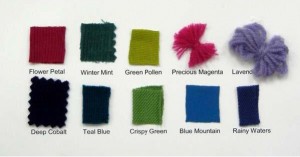
15 Nov Sustainable Color Communication: Methods for Communicating the Color Inspiration to the Supply Chain | Step 2
The cornerstone of a sustainable color communication program is to establish a method to transfer the designer’s color inspiration to the vendor and/or textile mill. The designer needs to have their palette colors converted into production achievable inspirations. This job can be directly done by the vendor/textile mill or a color standards provider, who translates the color inspiration into a production achievable inspiration for the vendor and/or textile mill. Today, both of these routes are commonly practiced but only one of these routes affords a more sustainable process.
Impact of directly communicating from designer to vendor/textile mill
The practice of sending color palettes directly from designer to vendor/textile mills has a negative impact on the planet, profit and people. How does this commonly practiced method have a negative impact? It starts with the source and size of the sample that is received by the vendors and/or textile mills. Typically, the source of the color is a cutting from a garment sample or a thread from a trend service. These types of samples leave a lot of open questions. What dyes were used to produce the color? Are they environmentally friendly? Are restricted substances present on the garment sample? Does the sample have a finish on it, such as softener? Is the garment sample color constant under different light sources?
In addition, the sample size passed directly from designer to vendor and/or textile is commonly too small (thumbnail size) to measure electronically or assess visually. As a result, the lab-dip process which the vendor and/or textile mill follows to convert the color inspiration into a production achievable sample takes longer and is more costly. Lab-dips are typically reviewed by sending physical samples via overnight couriers and it’s not uncommon that it may take up to five lab-dip sets (3 samples per submit) per color to get an approval.
From a planet perspective, this could leave a pretty hefty carbon emissions footprint. As an example, a one-way flight from China to the US will produce one ton of carbon dioxide (check it out https://www.carbonfootprint.com). As a visual picture, one ton is the quantity of air space filled up by a hot air balloon. That’s 5 hot air balloons worth of carbon dioxide for one color or 250 hot air balloons of carbon dioxide for a small 50 color palette! From a profit perspective, it has been communicated by DataColor that one lab-dip submit set costs about $225/color in lab and shipping costs. That equates to $11,250 for a small 50 color palette! In addition, the time it takes to exchange and review all of these lab-dips can take weeks and puts pressure on the already tight color development timelines. From a people perspective, the management of all these lab-dips is a daunting task. Typically, the information exchange is conducted via e-mail or spreadsheets. Hours are spent to just keep track of the data and communicate and in some cases, additional resources are required to keep up with the information.
Reducing the impact on planet, profit and people
Let’s take a look at the impact on the planet, profit, and people using the route of the designer sending the color inspirations first to a color service provider for translation and then to the vendor and/or textile mill for the lab-dip process. It is important to note that color service provider connected and networked with a dyestuff manufacturer will provide the most positive impact.
The role of the color service provider is to remove the unknown and non-uniform issues that may be associated with the color inspiration. The color standard provides answers to all the unknowns about the color inspiration; it uses globally available dyes; it is achievable in production scales; it provides environmental confidence; it affords color confidence; it avoids restricted substances; it is free of optical brightening agents and finishes. In addition, the standard is uniform in size for visual assessment, has an electronic form for electronic communication with spectrophotometers and is color constant with the desired light sources.
As a result, the color standard minimizes the impact on the planet, profit, and people. From a planet perspective, a color standard reduces the lab-dips required for color approval by 75%. Therefore, if we take the above 50 color palette, the carbon footprint using the color standard route will be reduced by 75% or a savings of 190 hot air balloons worth of carbon dioxide.
Carbon offsetting programs
That’s still a lot of hot air balloons, so for those looking to further reduce the carbon footprint of the lab-dipping process, you may want to consider investing in a carbon offsetting program. Couriers, like DHL, are launching plans in 2012 that allow customers to offset their carbon footprint by paying an additional fee per shipment. The additional fee is invested in an accredited environmental protection projects. From a profit perspective, the cost of lab-dipping for a 50 color palette will be reduced by 75% or a savings of $8,500 and the color development timeline will be shortened. From a people perspective, there will be fewer lab-dips to manage and track and as a result, personnel costs are contained and time is managed efficiently.
If you are already using a color service provider like Color Solutions International, then you are connected to the most sustainable color communication process available for designers, color managers, and product developers.
Related Posts
Sustainable Color Communication
Sustainable Color Communication – Step 1: Color Inspiration in Design



